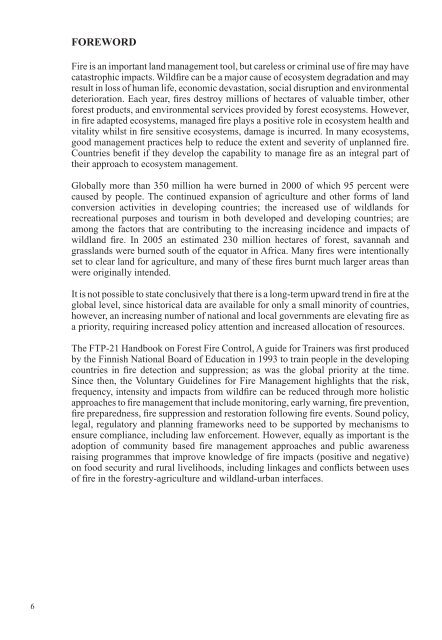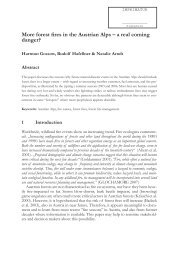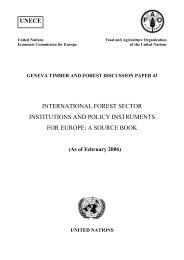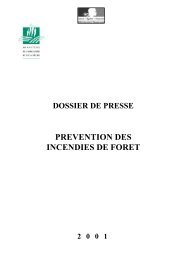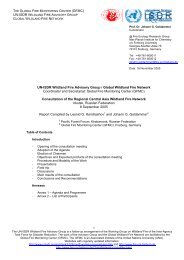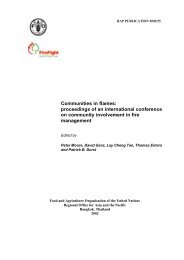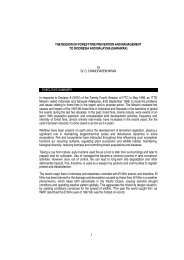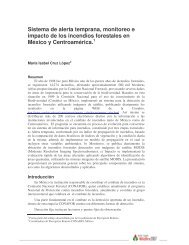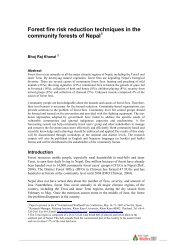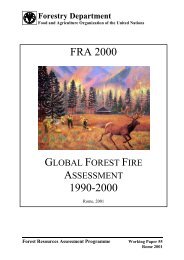Wildland Fire Management: Handbook for Trainers - The Global Fire ...
Wildland Fire Management: Handbook for Trainers - The Global Fire ...
Wildland Fire Management: Handbook for Trainers - The Global Fire ...
Create successful ePaper yourself
Turn your PDF publications into a flip-book with our unique Google optimized e-Paper software.
6<br />
FOREWORD<br />
<strong>Fire</strong> is an important land management tool, but careless or criminal use of fi re may have<br />
catastrophic impacts. Wildfi re can be a major cause of ecosystem degradation and may<br />
result in loss of human life, economic devastation, social disruption and environmental<br />
deterioration. Each year, fi res destroy millions of hectares of valuable timber, other<br />
<strong>for</strong>est products, and environmental services provided by <strong>for</strong>est ecosystems. However,<br />
in fi re adapted ecosystems, managed fi re plays a positive role in ecosystem health and<br />
vitality whilst in fi re sensitive ecosystems, damage is incurred. In many ecosystems,<br />
good management practices help to reduce the extent and severity of unplanned fi re.<br />
Countries benefi t if they develop the capability to manage fi re as an integral part of<br />
their approach to ecosystem management.<br />
<strong>Global</strong>ly more than 350 million ha were burned in 2000 of which 95 percent were<br />
caused by people. <strong>The</strong> continued expansion of agriculture and other <strong>for</strong>ms of land<br />
conversion activities in developing countries; the increased use of wildlands <strong>for</strong><br />
recreational purposes and tourism in both developed and developing countries; are<br />
among the factors that are contributing to the increasing incidence and impacts of<br />
wildland fi re. In 2005 an estimated 230 million hectares of <strong>for</strong>est, savannah and<br />
grasslands were burned south of the equator in Africa. Many fi res were intentionally<br />
set to clear land <strong>for</strong> agriculture, and many of these fi res burnt much larger areas than<br />
were originally intended.<br />
It is not possible to state conclusively that there is a long-term upward trend in fi re at the<br />
global level, since historical data are available <strong>for</strong> only a small minority of countries,<br />
however, an increasing number of national and local governments are elevating fi re as<br />
a priority, requiring increased policy attention and increased allocation of resources.<br />
<strong>The</strong> FTP-21 <strong>Handbook</strong> on Forest <strong>Fire</strong> Control, A guide <strong>for</strong> <strong>Trainers</strong> was fi rst produced<br />
by the Finnish National Board of Education in 1993 to train people in the developing<br />
countries in fi re detection and suppression; as was the global priority at the time.<br />
Since then, the Voluntary Guidelines <strong>for</strong> <strong>Fire</strong> <strong>Management</strong> highlights that the risk,<br />
frequency, intensity and impacts from wildfi re can be reduced through more holistic<br />
approaches to fi re management that include monitoring, early warning, fi re prevention,<br />
fi re preparedness, fi re suppression and restoration following fi re events. Sound policy,<br />
legal, regulatory and planning frameworks need to be supported by mechanisms to<br />
ensure compliance, including law en<strong>for</strong>cement. However, equally as important is the<br />
adoption of community based fi re management approaches and public awareness<br />
raising programmes that improve knowledge of fi re impacts (positive and negative)<br />
on food security and rural livelihoods, including linkages and confl icts between uses<br />
of fi re in the <strong>for</strong>estry-agriculture and wildland-urban interfaces.


